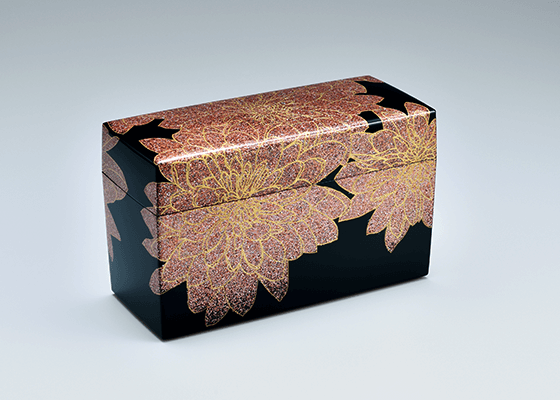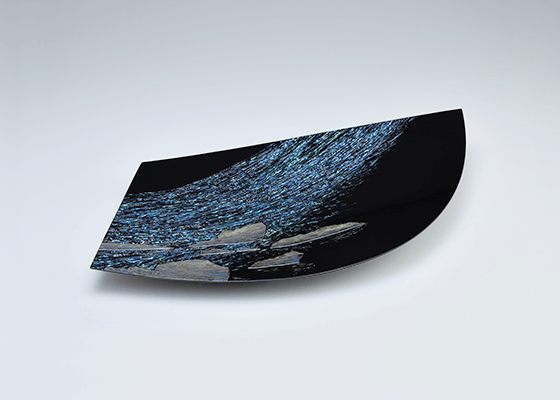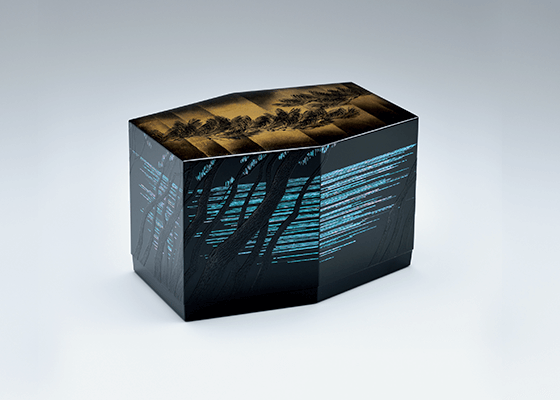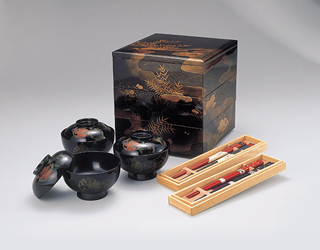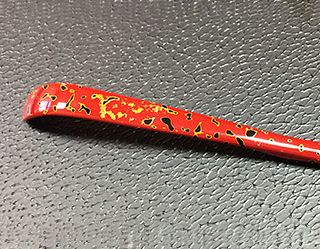LACQUERWARE
Description
Lacquerware is made by coating the surface of a material with the sap of the Japanese lacquer tree (Toxicodendron vernicifluum). When the lacquer (urushi) hardens, it polymerizes and forms a protective surface that repels water and resists corrosion. Lacquer has been used on everyday tools and utensils in Japan since ancient times, and lacquerware bowls, chopsticks, trays, and meal boxes continue to be widely used today.
Lacquer was first used as an adhesive in prehistory, and later as a coating. Decorative objects painted with red lacquer have been found at Jomon archaeological sites that date back to 9,000 years ago.
Historically, lacquer has been used along with materials such as gold, silver, and shell to create lavishly decorated boxes, as well as musical instruments, sword scabbards, and armor. Today, in addition to everyday utensils like bowls and trays, lacquer continues to be used to create beautiful works of fine craft including decorative boxes and tea utensils such as tea caddies (natsume) and incense containers (kōgō) for use in the tea ceremony.
Process
-
1 Base materials
Wood is predominantly used for bowls, boxes, plates, and trays. Other base materials include woven bamboo, bast fiber cloth or washi paper shaped on a mold, animal hide, metal, and ceramics.
-
2 Applying the lacquer
Lacquer is applied to the base material with a spatula or brush. After each coat, the lacquer is polished smooth. Repeated coats are applied to create the beautifully textured surface associated with lacquer.
-
3-1 Completed piece
-
3-2 The piece is further decorated using one or several techniques
Artistic Techniques
-
Lacquered bamboo
Bamboo is ideal for weaving various forms. The bamboo is split into thin strips, peeled, and coated with multiple layers of lacquer. Pieces of basketry made from lacquered bamboo (known as rantai) are lightweight and durable.
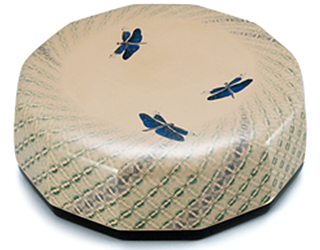
-
Dry lacquer
For works of dry lacquer (kanshitsu), first a clay form is created and plaster is used to take a mold of the form. Next, repeated layers of hemp cloth and lacquer are applied to the mold until they are built up to the desired thickness. Finally, the mold is removed and additional coats of lacquer are applied to finish the piece. The hemp fibers are strengthened when the lacquer bonds with them, making dry lacquer an excellent technique for creating sturdy forms with a significant degree of freedom.
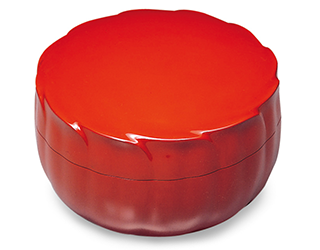
-
Maki-e
Maki-e (literally “sprinkled pictures”) is a representative lacquerware technique that originated in Japan around 1,200 years ago. Maki-e is done by painting lacquer motifs on the surface of a piece using a fine brush and then sprinkling gold powder onto the lacquer before it hardens, producing luxurious decorations.
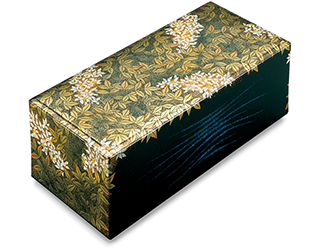
-
Mother-of-pearl inlay (Raden)
Mother-of-pearl inlay (Raden) is a decorative technique that uses the iridescent inner layer of abalone shell, turban shell, pearl oyster shell, or other mollusk shells. The technique came to Japan from China 1,300 years ago, and pieces featuring mother-of-pearl inlay are included among the artifacts at the Shōsōin Repository in Nara.
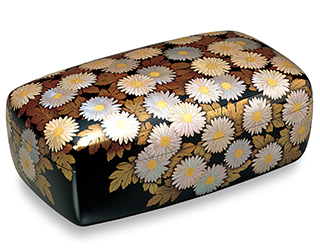
-
Chinkin
For chinkin (“sunken gold”), a chisel or knife is used to incise lines and dots into a lacquered surface. Gold leaf or fine gold powder is then inlaid into the grooves, creating a fine and delicate design.
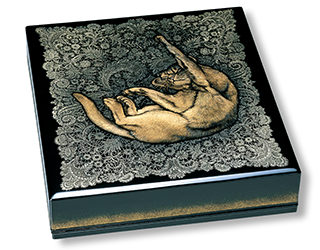
-
Kinma
There are three basic variations of kinma based on the method used for cutting the motifs: line cutting, dot cutting, and a combination of the two. All three types use a special carving blade known as a kinma ken. Originally, kinma only consisted of motifs made of incised lines. However, by combining a variety of colored lacquers and cutting techniques, the art has lent itself to increasingly complex designs.
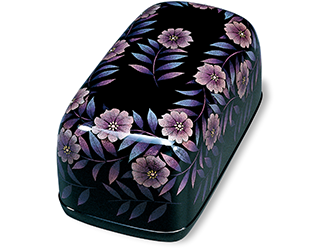
-
Carved lacquer
Carved lacquer (choshitsu) is made by first coating a piece in dozens of layers of colored lacquer. Then, a carving blade is used to cut into the lacquer and produce three-dimensional relief carvings.
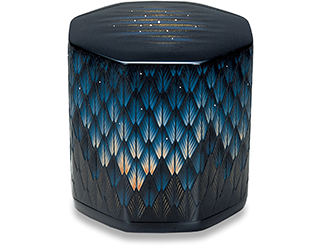
-
Metal sheet inlay
Metal sheet inlay (hyōmon) is a technique that involves cutting shapes out of thin sheets of gold, silver, or other metals to create an inlay motif.

-
Eggshell inlay
Eggshell inlays (rankaku) are created by applying finely crushed eggshells to painted lacquer motifs. The eggshells make it possible to create vivid whites, a color that is difficult to reproduce with colored lacquer. Normally, the shells of quail eggs are used.
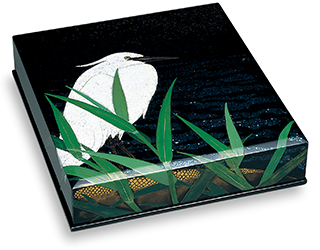
-
Urushi-e
Urushi-e (“lacquer pictures”) is a decorative technique that consists of motifs painted in colored lacquer. Urushi-e is the oldest and most fundamental decorative lacquer technique.
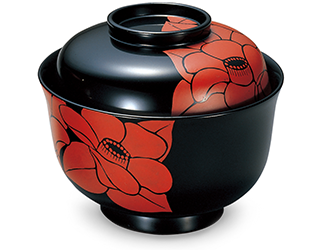
-
Kamakurabori
In Kamakurabori (“Kamakura carving”), raised designs are carved into wood and then coated with lacquer. The name refers to the city of Kamakura, but similar techniques are used throughout Japan.
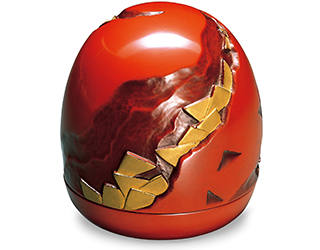
-
Lacquering
Lacquering (kyūshitsu) is the art of applying lacquer to a substrate using spatulas or brushes. The technique includes a range of processes, from reinforcing the substrate with cloth to building up the foundation and applying the middle- and top-coats. The final coat can be left as is (nuritate), polished with charcoal to a high-gloss finish (roiro shiage), or given one of several hundred alternative (kawarinuri) finishes. Lacquer application is known for both its technical difficulty and richly expressive qualities.
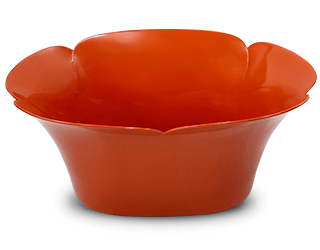
-
Zonsei
In zonsei lacquerwork, the outlines of colored motifs are engraved to produce additional decorative effects. Typically, one of two techniques is used. In the first, the artisan applies the motifs in colored lacquer before using a carving tool called a zonsei ken to incise the outlines of the design or add decorative line engravings. In the second, the artisan creates motifs using the kinma technique, which are then outlined or engraved in the same fashion. Zonsei, like carved lacquer (chōshitsu) and kinma, is a technique associated primarily with Takamatsu in Kagawa prefecture.
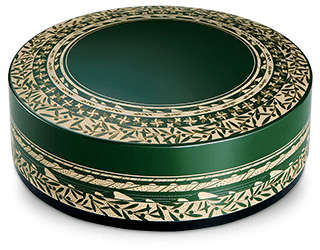
-
Reference: Nihon Kōgeikai Higashi Nihon Shibu (Japan Kōgei Association Eastern Branch), ed., Dentō kōgei-tte nani? – miru, shiru, tanoshimu gaido bukku (What Are Traditional Crafts? –A Guidebook to Seeing, Learning, and Enjoying). Unsodo, 2013.
Well-known crafts
-
Wajima lacquerwareOpen in new window
Wajima lacquerware is characterized by a profound color and luster, and a smooth texture. Gold leaf is used for inlay carvings and sprinkled powder. This craft also uses powdered diatomaceous soil as an undercoat to increase durability.
photo: Ishikawa Prefecture
Tourism League
-
Tsugaru lacquerwareOpen in new window
Tsugaru lacquerware features highly polished, smooth surfaces created by applying layer upon layer of colored lacquer over a tree base. Diverse coating techniques are used including the standard kara nuri, or monsha nuri which uses charcoal and black lacquer to leave a stylish impression.


